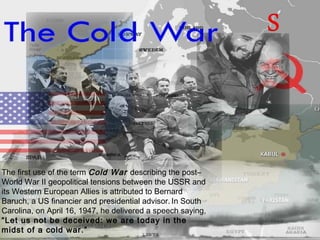
The cold war_begins_2-19
- 1. The first use of the term Cold War describing the post– World War II geopolitical tensions between the USSR and its Western European Allies is attributed to Bernard Baruch, a US financier and presidential advisor. In South Carolina, on April 16, 1947, he delivered a speech saying, “Let us not be deceived: we are today in the midst of a cold war.”
- 2. During the war, the U.S. and U.S.S.R. had enjoyed comparatively cordial relations. FDR had reasoned that, since the Soviet Union was powerful enough to take much of what it wanted, it was wise to recognize this ability, to arrive at working agreements in administering various areas, and to maintain unity with this other great power. The "Big Three" at the Yalta Conference, Winston Churchill, Franklin D. Roosevelt and Joseph Stalin (February 4–11, 1945)
- 3. It was on this basis that the administrative division of Korea was first effected and the four-power arrangement in Germany were concluded. The death of FDR (April 12, 1945) would mark a point of change in American foreign policy.
- 4. Harry Truman Josef Stalin
- 5. President Truman and his aides adopted a less friendly attitude toward the Soviet Union. At the same time, the Communist parties of the world gave up the united- front policy of the war years in favor of a line emphasizing the ultimate goals of Communism
- 6. These communist parties became considerably less conciliatory than before and the Soviets were backing down from their Yalta agreement to allow free and open elections in Eastern Europe. A transitional state of affairs prevailed in 1946: - The UN was functioning with some success (they were able to force the withdrawal of Soviet troops from Iran). -The Soviet Union sets up satellite nations on its western boundary – the “Iron Curtain” descended.
- 8. 1947 was the year of official breakdown of Soviet-American friendship and of U.S. statements to that effect. U.S. diplomat George Kennan, posted to the U.S. embassy in Moscow, would advise Truman to adopt a policy of containment of communism. This policy of containment would influence American foreign policy until the demise of the Soviet Union in the early 1990s. (either overtly or covertly)
- 9. 1947: The Truman Doctrine – provided for military and economic assistance to countries resisting communism; aimed specifically at Greece and Turkey 1948: The Marshall Plan – provided $13 billion in economic assistance for European recovery and to make a triumph of Communism less likely; the Soviets would not permit its satellites to participate 1949: NATO – North Atlantic Treaty Organization provided for a mutual- defense agreement among the U.S., Canada, and 10 European nations Signing of NATO
- 11. 1948: The Soviets tried to pressure the other 3 Allied powers (U.S. Great Britain, France) to turn over control of their sectors of Berlin. The Soviets blockaded all land routes into the Soviet sector of Germany and the three Allied sectors of Berlin. The U.S. and Great Britain began a ten month airlift of supplies into Berlin. In May 1949, the Soviets removed the blockade. However, the Soviets are able to successfully test their first atomic bomb that same year. By the time the Berlin Airlift ended a total of 278,228 U.S., British and French flights carried 2,326,406 short tons of material into the city. There were 39 British and 31 American airlift-related deaths during the difficult flights.
- 13. The U.S. had been backing the corrupt Nationalist government of China who were involved with the Communist Chinese in a lengthy civil war. In 1949 the Communists would drive the Nationalists from the mainland (they would find refuge on the island of Formosa). The U.S. saw this as a failure of the policy of containment and led some Americans to question how this could happen.Top right-Mao Zedong, Top left- Communist Propaganda poster, and bottom-communists enter Beijing.
- 14. In June 1950, North Korean forces would invade South Korea. President Truman immediately ordered military intervention (later ratified by the UN). North Korean troops would be pushed back. This limited war would continue until a ceasefire was negotiated in 1953 by new U.S. President Eisenhower.
- 15. Formation of SEATO (Southeast Asia Treaty Organization) in 1954 Established under Western auspices after the French withdrawal from Indochina, SEATO was created to oppose further Communist gains in Southeast Asia. Geneva Summit meeting with Khrushchev in 1955 The stated mission of the 1955 summit was to reduce international tensions. The Geneva Summit was seen as an extremely important building block to better friendships and more open communication between the leaders of 'The Big Four'.
- 16. Soviets crush Hungarian revolt in 1956 The Hungarian Revolution of 1956 was a spontaneous nationwide revolt against the Stalinist government - People's Republic of Hungary. Eisenhower Doctrine (aid to Middle Eastern countries to resist communism) announced in 1957 The Eisenhower Doctrine was announced by President Dwight D. Eisenhower in a message to the United States Congress on January 5, 1957. Under the Eisenhower Doctrine, a country could request American economic assistance and/or aid from U.S. military forces if it was being threatened by armed aggressor
- 17. Sputnik is launched in 1957 The aluminum sphere was the first man- made object to orbit the Earth, and its celestial presence electrified the world and kicked the Space Age into high gear, leading in short order to the formation of NASA. Missile-gap debate begins The missile gap was the term used in the United States for the perceived disparity between the number and power of the weapons in the U.S.S.R. and U.S. ballistic missile arsenals during the Cold War. U-2 incident in 1960 The 1960 U-2 incident occurred during the Cold War on May 1, 1960 when an American U-2 spy plane was shot down over the Soviet Union.